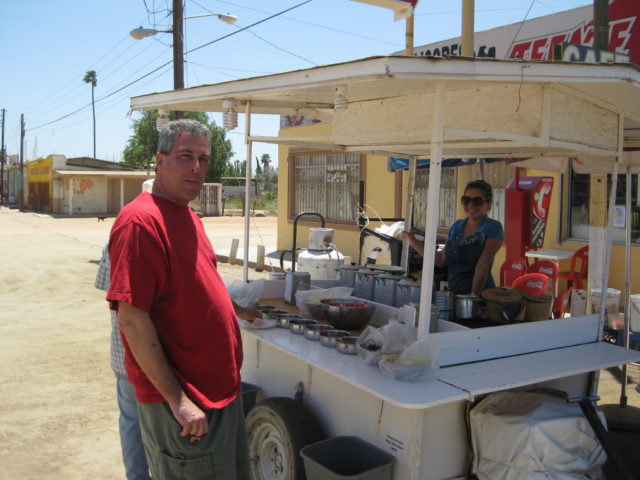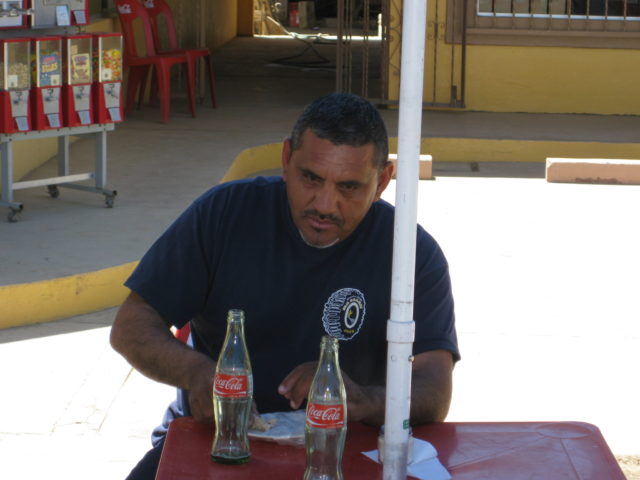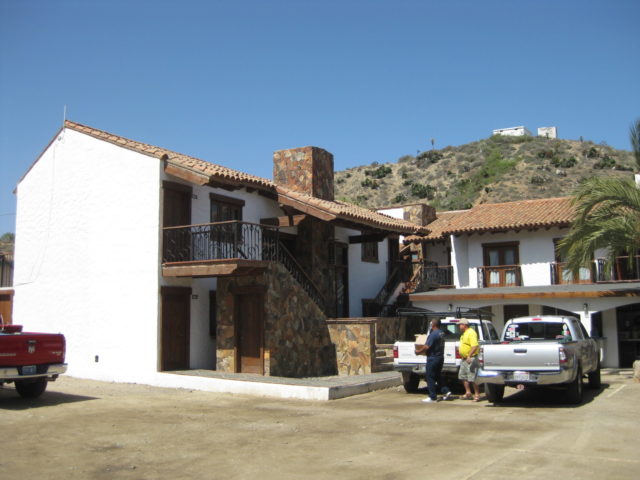In Arroyo el Volcán, we search for Mission Santa Isabel
The Lost Mission of Santa Isabel is an old legend, was born out of the idea that the Jesuits had accumulated treasures from the seventy years on the peninsula. A totally false theory. When these missionaries got advance warning that the Spanish Court was about to arrest them all, the legend says that they quickly built one final mission in a hidden canyon, beyond Mission Santa María.
A member of the Baja Nomad Internet community, with the handle ‘elbeau,’ using Google Earth, thought he saw some ruins that deserved to be investigated. It turned into a big deal and in just a few weeks, several of us traveled hundreds of miles to see what ‘elbeau’ was talking about. Here is that thread from 2011: http://forums.bajanomad.com/viewthread.php?tid=51399
Does everyone know where Arroyo El Volcán is or at least where where El Mármol onyx quarry is? El Mármol is 9 miles from Hwy. 1 at Km. 149, between El Rosario and Cataviña.
The arroyo is 4 miles from El Mármol and flows to the Gulf of California just south of El Huerfanito. The Mexican topo maps have mislabeled the arroyo as ‘Zamora’ and called the next arroyo south ‘El Volcán’!
El Volcán is a cold water geyser and an area of soda springs where onyx is slowly being formed. Much onyx is in the area, as well. The geyser is less than a half mile south of the road, in the arroyo. The lost mission site discovered by ‘elbeau’ is 4 miles to the north.
My fellow adventure seeker was Baja Nomad member ‘El Vergel’ (Vern) from the Los Angeles area and the beach campo south of San Felipe. ‘Baja Cat’ (José) who waited for us just across the border at Otay Mesa joined and traveled along with us on Friday.
We stopped for lunch in San Vicente at a taco cart operated by Gloria, who served us ‘tacos de borrego’ (lamb tacos) along with a cup of consommé de borrego to which we added onions and salsa… YUM



We arrived in El Rosario about 2:30 to fill our gas tanks and buy a few cases of Tecate and Dos Equis cerveza. I also wanted to show Vern the rooms at Baja Cactus Motel as they are so outstanding given the location and typical highway accommodations usually found in Baja.



Fuel prices in Baja (below the border region) were 8.77 pesos per liter for Magna and 9.87 for Premium. The exchange rate at Baja Cactus was 11.20 pesos per dollar and in Ensenada on Sunday was 11.00 pesos per dollar… both close to $3.00 per gallon.
The 56 mile drive down Highway One to the El Mármol road was a breeze and the signed road was at the 149 kilometer marker (measured from San Quintín). The next 9 miles to El Mármol are dirt, but some of the easiest dirt miles in Baja and would be a breeze for most vehicles.
We stopped to take new photographs of the schoolhouse ruins and cemetery before the final leg of today’s drive down to Arroyo el Volcán. I heard the sound of a speeding Toyota Tacoma and it was ‘TW’ (Tom) and his brother Bill arriving from an ice run to Cataviña (20 miles distant). José, Vern and I followed them down to the campsite in Arroyo El Volcán, 4 miles from El Mármol.
El Mármol, an abandoned onyx quarry and has the famous school house ruin. The world’s only school made from Onyx!
We stopped to take new photographs of the schoolhouse ruins and cemetery before the final leg of today’s drive down to Arroyo el Volcán. I heard the sound of a speeding Toyota Tacoma and it was ‘TW’ (Tom) and his brother Bill arriving from an ice run to Cataviña (20 miles distant). José, Vern and I followed them down to the campsite in Arroyo El Volcán, 4 miles from El Mármol.

Already there was ‘bajalou’, ‘dtbushpilot’ (David) and ‘XRPhlang’ (Phil) on the sand/gravel arroyo at the base of a giant rock face. That evening was plenty fun discussing just why the hell we all drove hundreds of miles and spent hundreds of dollars to be in such a place! It was great!

TW made a batch of grits to supplement our morning diet and we secured camp for the day’s hike. It looked on the map to be about 3-4 miles down the arroyo to the primary site of elbeau’s Santa Isabel (arches, stairways, fountains). I called the location ‘site B’ on my Google Earth map. Our camp was just a few hundred feet down the wash from the El Mármol-La Olvidada mine road (which was totally graded very recently).
Where I left off in Part 1 was near the end of the 4 mile hike down Arroyo El Volcán. As we looked high up the cliffs to the location of the corral in elbeau’s satellite images we could not see directly the level or semi-level area. It was out-of-sight, and some of us wished to find a way up there for a closer look… Now, if we only had a helicopter, like Erle Stanley Gardner did 40 some years ago!
bajalou had all the sites GPSed on his hand-held and I had the primary Santa Isabel site on mine… That was my goal: to get right to the spot that elbeau saw ‘man-made’ structures like arches, stairways, fountains, etc. If that was there, then we would look for the others places later.
On the Google Earth image, the site is just off the main arroyo, along a side gully…
THAT’S IT! (well, that’s all we have agreed to show you… you should have joined us!)
Seriously, there is MUCH MUCH more to this trip…
El Vergel and BAJACAT continued up Arroyo Santa Isabel some distance, as did dtbushpilot and XRPhlang (while I was climbing the north slope for the above photos)… BAJACAT gave something to the mountain (I will let him share that with you). We all got bloodied on the brush or rocks.
BAJACAT and El Vergel continued further down Arroyo El Volcán and found bigger pools of water (photos coming).
The hike back to our camp seemed much longer, as the temperatures were higher and water was running out…
That afternoon, after a good rest, we drove up to La Olvidada mine and also the small onyx mine at El Volcán.
The next day (Sunday) we explored the El Volcán geyser and surroundings… so STAY TUNED, plenty more high adventure and photos coming!!!
It was 4 miles from Santa Isabel back to our camp, I walked with David and Phil for about a half mile after we left the three Corral explorers (TW, Bill, Lou)… and decided to wait and see if any of the 5 were going to get a move on…
Tired of waiting, I decided to march on solo… About a kilometer from camp, I took a break in the shade of a cliff and after maybe 15 minutes, here comes El Vergel… We finish the trip back together.
Here are some photos of Arroyo El Volcán on the return:
After resting up from the big hike, later Saturday afternoon we took a drive to see the La Olvidada (The Forgotten) Barite Mine. Along the way and on the return we take a look at the White Slope of springs just east of Arroyo El Volcán.
Coming next… EL VOLCÁN, BAJA’S COLD WATER GEYSER!
OKAY, who wants to know what barite is? (from Wikipedia)
Baryte, or barite, (BaSO4) is a mineral consisting of barium sulfate.[2] The baryte group consists of baryte, celestine, anglesite and anhydrite. Baryte itself is generally white or colorless, and is the main source of barium. Baryte and celestine form a solid solution (Ba,Sr)SO4.[1]
The name baryte is derived from the Greek word (heavy). The American spelling barite is used by the USGS and more often used in modern Scientific journals including those published by the Netherlands-based Elsevier journals. The International Mineralogical Association adopted “barite” as the official spelling when it formed in 1959, but recommended adopting the older “baryte” spelling in 1978,[8] notably ignored by the Mineralogical Society of America. The American Petroleum Institute specification API 13/ISO 13500 which governs baryte for drilling purposes does not refer to any specific mineral, but rather a material that meets that specification, in practice this is usually the mineral baryte.
The term “primary baryte” refers to the first marketable product, which includes crude baryte (run of mine) and the products of simple beneficiation methods, such as washing, jigging, heavy media separation, tabling, flotation. Most crude baryte requires some upgrading to minimum purity or density. Baryte that is used as an aggregate in a “heavy” cement is crushed and screened to a uniform size. Most baryte is ground to a small, uniform size before it is used as a filler or extender, an addition to industrial products, or a weighting agent in petroleum well drilling mud.
Uses
Some 77% worldwide is used as a weighting agent for drilling fluids in oil and gas exploration to suppress high formation pressures and prevent blowouts. As a well is drilled, the bit passes through various formations, each with different characteristics. The deeper the hole, the more barite is needed as a percentage of the total mud mix. An additional benefit of barite is that it is non-magnetic and thus does not interfere with magnetic measurements taken in the borehole, either during logging-while-drilling or in separate drill hole logging. Barite used for drilling petroleum wells can be black, blue, brown or gray depending on the ore body. The barite is finely ground so that at least 97% of the material, by weight, can pass through a 200-mesh screen, and no more than 30%, by weight, can be less than 6 μm diameter. The ground barite also must be dense enough so that its specific gravity is 4.2 or greater, soft enough to not damage the bearings of a tricone drill bit, chemically inert, and containing no more than 250 milligrams per kilogram of soluble alkaline salts.
Other uses are in added-value applications which include filler in paint and plastics, sound reduction in engine compartments, coat of automobile finishes for smoothness and corrosion resistance, friction products for automobiles and trucks, radiation-shielding cement, glass ceramics and medical applications (for example, a barium meal before a contrast CAT scan). Baryte is supplied in a variety of forms and the price depends on the amount of processing; filler applications commanding higher prices following intense physical processing by grinding and micronising, and there are further premiums for whiteness and brightness and color.
Historically baryte was used for the production of barium hydroxide for sugar refining, and as a white pigment for textiles, paper, and paint.
Although baryte contains a “heavy” metal (barium), it is not considered to be a toxic chemical by most governments because of its extreme insolubility.
===========================================
I got a chunk of rock piled up outside the mine, and it is strangely heavy for its size… like metal would be. 
On Saturday afternoon, after visiting the Olvidada barite mine and white slope of springs, we drove south on the road along the east edge of the El Volcan arroyo gorge… It goes about 3/4 a mile past some onyx mine activity and then drops steeply down to the arroyo.
Coming back up the steep grade gave me an opportunity to demonstrate the Tacoma’s A-TRAC traction system to Vern (a Jeep owner)!
[A-TRAC or Active Traction Control is Toyota’s answer to front and rear lockers to achieve maximum traction. A-TRAC is available on the Off Road TRD 4WD Tacoma since the 2009 model. Using the ABS brakes and spin sensors, any tire that starts to spin from a loss of traction gets braked to match the rotation on the opposite tire on that axle… an automatic locker effect for all 4 tires… however, steering ability is uneffected]
Once back up to the mine area, we hike around… and eventually go to the edge of the gorge where we look down on the giant dome that is EL VOLCÁN… Baja’s ‘Cold-Water’ geyser!
On Sunday, we return in the arroyo with BAJACAT and have a very close look at the geyser. Vern even took some videos of the activity… so stay tuned for Sunday’s photos!
A visit to the El Volcán Cold Water Geyser is one of Baja’s must-do events. To catch the monthly eruption (in the daytime) would be perhaps the most amazing thing to experience in Baja. When we were in the area 11 years ago, my travel amigo Lorenzo de Baja considered setting up a camp for up to a month to witness the event!
I have no knowledge of any photos or documentation of the eruption other than in Walt Peterson’s ‘The Baja Adventure Book’ describing the event as a 60 foot plume of water and gas (CO2?) lasting several minutes.
A visit to the El Volcán Cold Water Geyser is one of Baja’s must-do events. To catch the monthly eruption (in the daytime) would be perhaps the most amazing thing to experience in Baja. When we were in the area 11 years ago, my travel amigo Lorenzo de Baja considered setting up a camp for up to a month to witness the event!
I have no knowledge of any photos or documentation of the eruption other than in Walt Peterson’s ‘The Baja Adventure Book’ describing the event as a 60 foot plume of water and gas (CO2?) lasting several minutes.
One last look at El Volcán:
Sign pointing the way to El Volcán (4 miles) and La Olvidada (10 miles). It is 9 miles from this point back to Hwy. 1 (Km. 148/9). Rancho Sonora is just south of the El Mármol jcn.
See the onyx gifts for sale there!



















